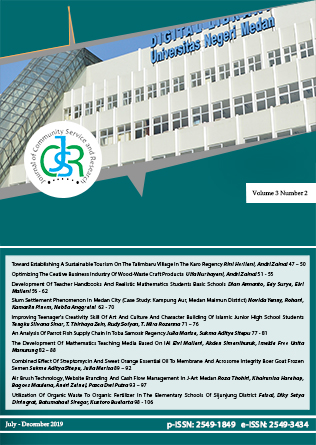DEVELOPMENT OF TEACHER HANDBOOKS AND REALISTIC MATHEMATICS STUDENTS BASIC SCHOOLS
DOI:
https://doi.org/10.24114/jcrs.v3i2.15954Abstract
The research aims to develop teacher and student handbooks for realistic mathematics lessons for elementary schools. The development of this handbook is based on the reality in the field where the handbook of teachers and students especially the subjects using the 2013 curriculum still do not exist, and in daily learning activities teachers and students still use books that use themes. This research uses development research (Developmental Research). The subjects of this study were grade V students of SD Negeri 163085, H.A Bilal Tebingtinggi City and SD Negeri 106162, Medan Estate District, Deliserdang Regency. In the initial stage, observations were made during the learning process at the two schools and continued with interviews with students and teachers. From the results of these observations and interviews a primary school realistic mathematics teacher and student handbook was prepared. Furthermore, the realistic elementary school mathematics teacher and student handbook is validated by a team that aims to see and assess the quality of the realistic elementary school teacher and student mathematics handbook in order to arrange an effective handbook that will be used by teachers and students in learning. The validation results show that realistic mathematics teacher and student handbooks are developed in both categories and can be used in teaching and learning. The media book test was conducted on grade V students of SD Negeri 163085 Tebingtinggi city and SD Negeri 106162 Medan Estate Deliserdang Regency. The trial results show that the elementary school teacher and student mathematics handbook is effective and can help facilitate understanding of mathematical concepts at the elementary school level. This can be seen from the number of students who can reach the KKM from the two schools is increasing. For SD Negeri 163085 HA Bilal, Tebingtinggi City, if at the time of the pre-test only 1 student (3%) was able to reach the KKM, then after being given the learning process using a teacher and student handbook developed the number of students who could reach the KKM increased to 24 students (82.7%) while those under the KKM were only (17.3%) or 5 students. The same thing was seen in SD Negeri 106162, Medanestate Subdistrict, Deliserdang Regency. If at the time of the Pre-test only 2 students (6.6%) had scored above the KKM, after the post-test there was an increase in students who achieved the KKM score of 25 students (83.3%). An increase of 76.7% when compared to the pre test. Keywords: Handbook, teacher, student, PMRDownloads
Published
2019-12-24
Issue
Section
Articles
License
Authors who publish with this journal agree to the following terms:
- Authors retain copyright and grant the journal right of first publication with the work simultaneously licensed under a Creative Commons Attribution License that allows others to share the work with an acknowledgment of the work's authorship and initial publication in this journal.
- Authors are able to enter into separate, additional contractual arrangements for the non-exclusive distribution of the journal's published version of the work (e.g., post it to an institutional repository or publish it in a book), with an acknowledgment of its initial publication in this journal.
- Authors are permitted and encouraged to post their work online (e.g., in institutional repositories or on their website) prior to and during the submission process, as it can lead to productive exchanges, as well as earlier and greater citation of published work (See The Effect of Open Access).
- This work is licensed under a Creative Commons Attribution-ShareAlike 4.0 International License.
This work is licensed under a Creative Commons Attribution-ShareAlike 4.0 International License.


